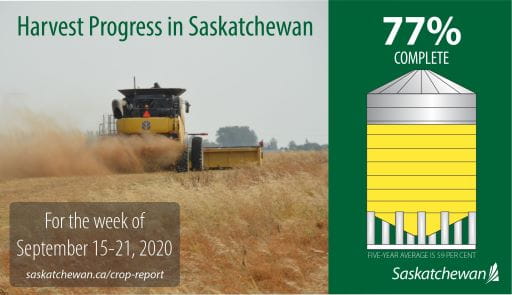Released on September 24, 2020
Relatively warm, dry conditions this week allowed farmers to make good harvest progress. Rainfall on the weekend caused some delays but many farmers have since returned to the field. Several farmers are hoping for warm, dry conditions to favour dry down of crops, though producers near harvest completion are hoping for rain to rejuvenate topsoil and subsoil moisture before winter.
Seventy-seven per cent of the 2020 crop is currently in the bin, which is up from 62 per cent last week, and remains well ahead of the five-year (2015-2019) average of 59 per cent for this time of year. An additional 18 per cent of the crop is swathed or ready to straight-cut. Much of the crop coming off in the central and northern regions is tough and requires aeration or drying.
Harvest is most advanced in the southwest region, where 96 per cent of the crop is now combined. The southeast region has 89 per cent combined and the west-central 78 per cent. The east-central region has 69 per cent combined, the northeast 51 per cent and the northwest 43 per cent.

Ninety-nine per cent of lentils, 98 per cent of field peas, 95 per cent of durum, 86 per cent of barley, 77 per cent of chickpeas, 74 per cent of spring wheat, 71 per cent of oats, 61 per cent of canola and 52 per cent of flax has been combined. An additional 35 per cent of canola is swathed or ready to straight-cut.
Many areas of the province received rainfall this past weekend, particularly in parts of the western and northern regions. The Tyner area in the southwest region received the highest amount of rain this week with 99 mm.
Provincial cropland topsoil moisture is rated as 37 per cent adequate, 39 per cent short and 24 per cent very short. Hay and pasture land topsoil moisture is rated as 27 per cent adequate, 38 per cent short and 35 per cent very short. These conditions have slightly improved this week in areas thanks to the recent rain.
The majority of crop damage this week was due to wind, frost, waterfowl, wildlife and lack of moisture. Heavy rain in some areas has resulted in lodging of crops. We would like to remind producers that Saskatchewan Crop Insurance Corporation provides compensation for damage caused by wildlife through the Wildlife Damage Compensation Program. You do not need to be an existing Crop Insurance customer to file a claim. If you do experience wildlife damage, please report it immediately by visiting https://www.scic.ca/wildlife/ or calling 1-888-935-0000.
Pasture conditions are rated as two per cent excellent, 16 per cent good, 32 per cent fair, 33 per cent poor and 17 per cent very poor. Conditions vary across the province, with the northern regions rating most of the pastures as in fair-to-good condition and the southern regions having more pastures rated as very poor-to-fair condition.
Farmers are busy combining, hauling bales and moving cattle.
With harvest underway in Saskatchewan, we want to remind producers to exercise caution and remain safe.
A complete, printable version of the Crop Report is available online at https://www.saskatchewan.ca/crop-report.
Follow the 2020 Crop Report on Twitter at @SKAgriculture.
-30-
For more information, contact:
Sara Tetland
Agriculture
Moose Jaw
Phone: 306-631-0483
Email: sara.tetland@gov.sk.ca

